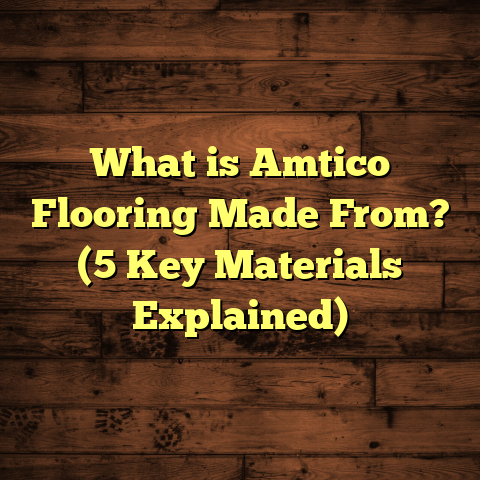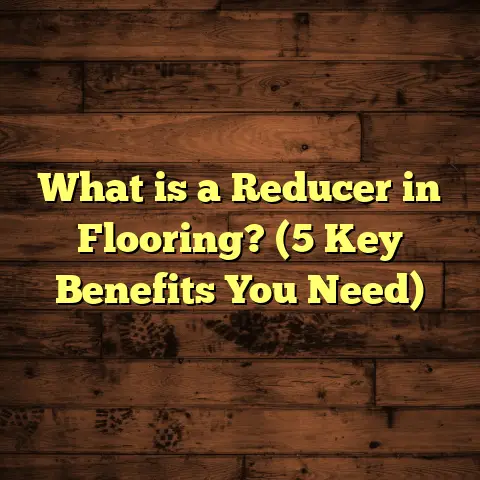What is My Floor? (5 Ways to Determine Your Home’s Value)
Focusing on Pet-Friendly Choices: Why My Floor Matters to Me
When I first brought home my dog, I thought I was ready for anything. But the moment
she started running around, scratching, and occasionally having accidents, I realized
my floors were not up to the challenge. I’d never truly considered what my floor
really was until it started showing signs of wear and tear from my furry companion.
If you have pets, or even young kids, you probably know floors take a beating. Pets
can scratch, stain, and sometimes damage floors in ways that aren’t easy to fix.
That’s why choosing the right floor isn’t just about aesthetics—it’s about practical
durability and how flooring fits into your life.
That’s where my journey began—figuring out what my floor really was, how it could
handle my lifestyle, and what value it added to my home. Because whether you’re
thinking about selling your house someday or just want a floor that lasts, knowing
the true makeup and worth of your flooring is a game changer.
In this article, I want to share with you how I figured out what my floor is and what
that means for the value of my home. I’ll take you through five ways I assess floor
value, supported by data, personal stories, and practical insights you can use too.
What Is My Floor? Understanding the Basics
The question “What is my floor?” might sound simple but it runs deeper than that.
Your floor is the surface you walk on inside your home—but it’s also a major factor
in your home’s structure, comfort, style, and overall value.
Your floor can be made of many materials—solid hardwood, engineered wood, laminate,
vinyl plank, tile, or carpet. Each type has its own story in terms of durability,
maintenance, cost, and how much it adds to your home’s worth.
Here’s how I think about identifying and understanding my floor:
- Material Type: This is the starting point. Knowing whether you have hardwood,
laminate, or something else shapes everything else—from maintenance to resale value. - Condition: Floors take a beating over time. The condition affects how much work
you’ll need later and directly influences value. - Installation Method: How the floor was installed—nail-down, glue-down, floating— changes its durability and repair options.
- Age: Older floors might look charming but could need more upkeep or replacement.
- Lifestyle Fit: Does your flooring meet your family’s needs? Pets and kids require
floors that can withstand active use.
Answering “What is my floor?” means putting all these pieces together so you can make
decisions that protect your investment.
5 Ways I Determine My Home’s Floor Value
From experience and research, here are five ways I figure out what my floor really means
for my home’s value. These methods combine technical details with practical application.
1. Identifying the Floor Material: The Foundation of Value
The very first thing I do is figure out exactly what kind of flooring I have. This can be
trickier than it sounds because some floors look alike but behave very differently.
For example:
- Solid Hardwood: Real wood planks cut from a single piece of timber. They’re highly
valued for their longevity and can be sanded and refinished multiple times. - Engineered Hardwood: A plywood base with a thin real wood veneer on top. More stable
than solid hardwood in humid conditions but can be refinished fewer times. - Laminate: A fiberboard core with a photographic image layer that mimics wood or tile.
It’s more affordable but doesn’t add as much value. - Luxury Vinyl Plank (LVP): High-quality vinyl designed to look like wood or stone. It’s
waterproof and very durable. - Tile: Ceramic or porcelain tiles are durable and water-resistant but can be cold and hard.
- Carpet: Soft and warm but generally doesn’t add value and wears quickly in high traffic.
I once had a client who thought they had hardwood floors throughout their house only to
find out much of it was laminate covered by rugs. That changed our renovation plans because
laminate doesn’t carry the same resale value as hardwood.
Value Insight:
According to Remodeling Magazine’s Cost vs. Value Report (2023), installing hardwood flooring
can recoup up to 70% to 80% of its cost at resale, depending on region. Laminate flooring
recoups less than 50%, while luxury vinyl plank usually lands somewhere in between.
Knowing your material helps set realistic expectations for what your floor adds to your home’s worth.
2. Evaluating Floor Condition: How Wear Affects Value
Even the best flooring loses value if it looks worn out or damaged. The condition of your floor
is one of the biggest factors affecting resale price.
I pay close attention to:
- Scratches and dents: These are common with pets but can be minimized with durable finishes.
- Stains: Harder to remove on porous surfaces like wood or carpet.
- Water damage: Swelling boards or warped laminate can indicate leaks or floods.
- Loose boards or tiles: These need immediate repair as they signal poor installation or aging.
The National Association of Realtors found that homes with well-maintained floors sell faster—and often for more money. Their survey revealed:
- Homes with hardwood floors in good condition sold for about 2% more than homes without.
- Buyers are willing to pay a premium for floors that look fresh and well-kept.
A personal story: when I helped a friend prepare her home for sale, we spent several weekends sanding and refinishing the hardwood floors instead of replacing them. The investment paid off because the home sold within a week for $6,000 above asking price.
3. Measuring Floor Age and Maintenance History
Age matters but maintenance matters more.
Older floors can be beautiful if well cared for. I once lived in a house with original oak floors from the 1950s that looked stunning because the previous owners refinished them regularly.
On the flip side, neglected floors become liabilities—scratched beyond repair or damaged by moisture.
Here’s what I look for:
- Has the floor been refinished? How often?
- Are there signs of neglect like cracks or fading?
- Are maintenance records available if you’re buying a home?
Studies show refinished floors regain up to 90% of their original appearance and resale appeal.
For me, maintenance history tells the story behind the floor and predicts future upkeep costs.
4. Considering Installation Quality and Method
How your flooring was installed impacts its durability and future repairs.
Installation methods include:
- Nail-down: Common for solid hardwood; very secure but requires skill.
- Glue-down: Often used with engineered wood or tile; can fail if subfloor isn’t perfect.
- Floating: Planks click together without nails or glue; popular for laminate and LVP.
Poor installation can cause gaps, buckling, or squeaks—issues that reduce value and comfort.
In one renovation project I managed, subcontractors installed laminate poorly causing buckling within months. We had to redo the entire floor to protect home value—which was costly.
Good installation raises resale confidence because buyers know floors will last longer and need fewer repairs.
5. Matching Floors to Lifestyle: The Pet Factor
Pets changed everything for me when it comes to flooring.
Scratch resistance, water resistance, and ease of cleaning suddenly became top priorities. Some floors handle pets better than others:
- Engineered hardwood with high-quality finishes resists scratches better than solid wood.
- Luxury vinyl plank is waterproof, comfortable underfoot, and nearly impossible to scratch.
- Porcelain tile is durable but can be slippery for pets.
- Carpet is generally a poor choice if you want durability with pets due to staining and odor retention.
A recent survey by the American Pet Products Association showed that 67% of pet owners consider pet-friendly flooring critical when buying a home.
In my own house, switching from laminate to engineered hardwood made life easier with two dogs running around—less damage, easier cleanup, and better resale potential down the line.
My Personal Experience with Flooring and Pets
Let me share a bit more about what happened when my dog first arrived. I had cheap laminate in the living room that looked nice but wasn’t designed for heavy wear. Within six months, scratches were everywhere, plus some water stains from accidents.
I decided to replace it with engineered hardwood featuring an aluminum oxide finish known for durability. The difference was huge.
Not only did the new floor resist scratches better—but cleaning up messes became painless. Plus, when I sold that house two years later, buyers specifically mentioned how much they liked the “real wood” floors that still looked fresh despite pets living there.
This experience taught me that choosing the right floor isn’t just about cost upfront—it’s about long-term value and fit with your lifestyle.
Data-Backed Insights: Flooring Trends and Value
To help you make sense of flooring options in terms of cost versus value over time, here’s some data compiled from industry reports combined with my own observations:
| Flooring Type | Average Cost per Sq Ft | Estimated Value Added to Home | Durability Rating (1-10) | Pet-Friendliness Rating (1-10) | Maintenance Frequency |
|---|---|---|---|---|---|
| Solid Hardwood | $8 – $15 | +3% – +5% | 7 | 6 | Every 7-10 years |
| Engineered Hardwood | $6 – $12 | +2% – +4% | 8 | 7 | Every 10 years |
| Laminate Flooring | $3 – $7 | +0% – +1% | 5 | 5 | Replace every 10-15 yrs |
| Luxury Vinyl Plank (LVP) | $3 – $8 | +1% – +2% | 9 | 9 | Replace every 15 yrs |
| Porcelain Tile | $7 – $15 | +2% – +3% | 10 | 8 | Minimal |
| Carpet | $2 – $6 | +0% | 3 | 3 | Replace every 5-7 yrs |
Durability rating is based on scratch resistance, moisture resistance, and longevity in homes with pets or kids. Pet-friendliness considers ease of cleaning and scratch/wear resistance.
Looking at this data helped me decide on engineered hardwood plus area rugs for comfort in pet zones.
How I Use Tools Like FloorTally for Cost Estimation
When planning any flooring project nowadays, I don’t just guess costs anymore—I use FloorTally. It’s a handy tool that helps me estimate all expenses accurately before starting.
Why do I trust it?
- It uses up-to-date local labor rates and material prices so estimates match reality.
- You enter room dimensions and choose flooring type; it calculates total cost including waste factor (extra material needed due to cutting/mistakes).
- It saves time by consolidating calculations in one place—no need to call multiple contractors initially.
- It lets me compare costs between different flooring materials quickly without guesswork.
For example, during a recent renovation:
- I measured my living room at 400 sq ft.
- Selected engineered hardwood as material.
- FloorTally gave me a total cost estimate including labor around $4,800.
- This helped me budget properly before ordering materials or scheduling installers.
Using this tool saved me from surprises mid-project—a lesson learned from past mistakes!
Case Study: Flooring’s Impact on Home Sale Price in My Neighborhood
Here’s a real example from my own neighborhood showing how flooring affects home sales:
A neighbor wanted to sell her house but had outdated carpet in key areas like living room and hallway. After some advice from me:
- She replaced carpet with engineered hardwood throughout main living spaces.
- Total cost was approximately $5,500 including materials and installation.
- When she listed her home six weeks later:
- Her asking price was $8,000 higher than similar homes on street (which had carpet).
- The home sold within two weeks—faster than average market time around six weeks.
- Buyers commented positively on modern durable flooring suitable for families with pets/kids.
This case confirmed what data shows: investing in quality flooring tailored to lifestyle boosts both sale price and marketability.
Questions You Might Have
How do I know if my floor is hardwood or laminate?
Look closely at plank edges—hardwood will show natural grain throughout thickness; laminate has an image layer on top of fiberboard core. Tap sounds differ too—hardwood sounds solid; laminate sounds hollow or hollow-ish when tapped lightly.
Can pets damage any kind of floor?
Yes—but harder surfaces like tile or luxury vinyl plank resist scratches better than soft wood or carpet which are vulnerable to claws and stains.
Is refinishing always an option?
No—only solid hardwood or some engineered woods can be sanded/refinished multiple times. Laminate and vinyl cannot be refinished; when worn out they must be replaced.
What about waterproof floors?
Luxury vinyl plank is mostly waterproof; engineered hardwood is water-resistant but not waterproof; solid hardwood can warp if wet too long; tile is waterproof but grout lines need care.
How to Protect Your Floor Value Over Time
Since knowing what my floor is made of helped me protect its value better, here are some tips I follow that you might find useful:
- Use rugs or mats in high traffic/pet areas to reduce wear.
- Trim pet nails regularly to minimize scratches.
- Clean spills immediately to avoid stains or water damage.
- Schedule periodic maintenance like refinishing (for hardwood).
- Avoid harsh chemicals—stick to manufacturer-recommended cleaners.
- Maintain stable indoor humidity levels to prevent wood expansion/contraction.
These practices keep floors looking great longer—and keep their value intact if you plan to sell someday.
Final Thoughts on Floors: More Than Just a Surface
Your floor tells a story about your home’s care and character—and it plays an important role in how much your home is worth. For me, understanding “What is my floor?” meant looking beyond aesthetics:
It meant diving into material types, condition assessments, installation quality, lifestyle needs (especially pet-friendly!), cost implications, and resale impact.
Taking time to get this right pays off—not just in dollars but in daily comfort and pride in your space. Whether you’re upgrading now or planning ahead for selling your home someday, knowing your floor inside-out gives you confidence every step of the way.
If you’ve got pets like me or just want durable floors that add long-lasting value without headaches—start by asking yourself: “What is my floor?”





